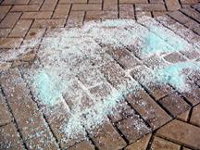Salt and storm water
LEARN MORE ABOUT STORM WATER RUNOFF
Wisconsin winters cause us to rely heavily on salting our roads, parking lots and sidewalks. But high salt use causes Wisconsin’s lakes, streams and drinking water to suffer. The growing salt problem threatens our fish and other aquatic life, and our groundwater that supplies our drinking water. We can continue to keep our roads, parking lots and sidewalks safe by using the right amount of salt. Take action by participating in one of the winter salt certification training sessions held throughout the state.
Winter salt certification training
Training is available for both municipalities and private contractors.
- Dane County
- Fox-Wolf Watershed Alliance
- Milwaukee River Keeper
- Southeastern Clean Water Network and Root-Pike-WIN
- Freshwater Road Salt Symposium Fall 2019
Additional resources
- Milwaukee River Keeper
- Minnesota Pollutant Control Agency - Chloride (salts)
- Wisconsin Salt Wise Partnership
- Case study: City of Cudahy Public Works presentation
- EPA Risk Assessment - Salt
Chlorides Workgroup Recommendations on a Statewide Chloride Strategy: Report to Water Initiatives Steering Committee
The Water Initiatives Steering Committee is comprised of DNR staff representing several agency programs. The Committee is responsible for evaluating and directing the integrated efforts of field and central office staff on key surface water and groundwater quality activities. The Chloride Workgroup was chartered in April of 2021 to gain a better understanding of the chloride pollution problem statewide, identify available data for chlorides in Wisconsin, and gather data that did not already exist, with an end goal of developing a statewide strategy for chloride reduction.
The group met monthly beginning in July 2021 and heard presentations from a number of professionals working on chlorides issues to help formulate recommendations. After hearing from these individuals and reviewing the data, the group developed a set of recommendations Wisconsin could pursue to address areas where water quality criteria are not being met and to slow the increase of chloride contamination in the state’s surface and drinking water. The recommendations include education and training, regulatory and policy, monitoring and financial support efforts.
To learn more about the Chlorides Workgroup results, see these reports:
- Chlorides Workgroup Recommendations on a Statewide Chloride Strategy: Report to Water Initiatives Steering Committee. Dec. 2022
- Freshwater Salinization Within La Crosse County Waters: Current Status, Consequences and Solutions. Dec. 2022

